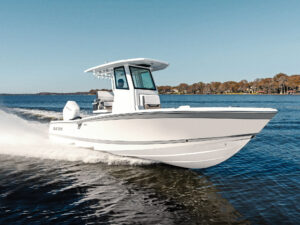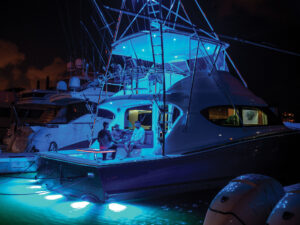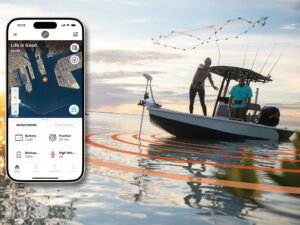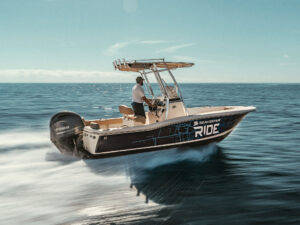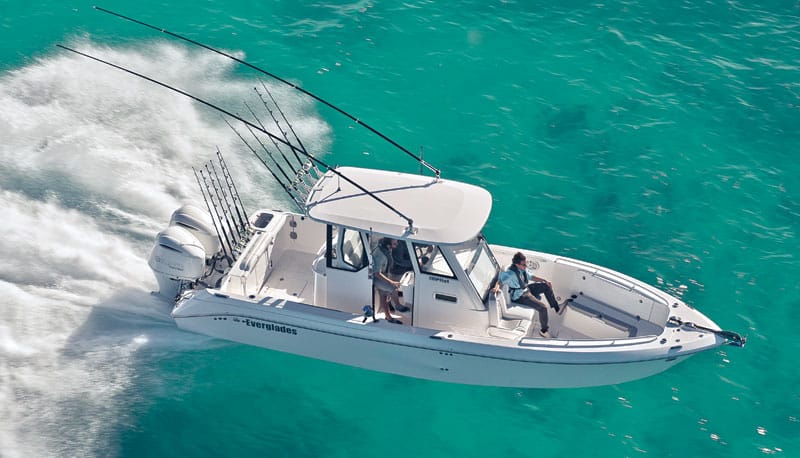
Everglades 295 Pilot
Everglades Boats has long been known as an innovator in outboard-powered fishing boats. From its exclusive Rapid Molded Core Assembly Process (RAMCAP) to creations like powered windshields and functional, stylish seating systems, Everglades constantly evolves and challenges the rest of the industry.
Everglades is never hesitant to try out a new design either, and from this philosophy, the new 295 Pilot was born. The company has built pilothouse boats before, and the configuration is a staple in cold-weather climates like the Pacific Northwest and New England, but this new pilothouse model offers more.
I tested the 295 from Plantation Boat Mart in Tavernier, Florida, not exactly the heart of cold-weather country. Admittedly, a pilothouse boat looks out of place in the Florida Keys, but after spending a morning running it around Florida Bay, I could see lots of practical applications for it in that part of the world and others.
I thought about the countless days I have had to punch through thunderstorms on the way back to shore, having been cut off from land by black clouds. It certainly would be nice to have a solid 360-degree enclosure in which to hide in those situations. Add the option of air conditioning and heat, and the comfort level rises even more.
The solid fiberglass pilothouse features removable sliding fiberglass doors, so if you don’t want the AC option, you can still get plenty of airflow in the summer. Add to those the standard hydraulic tempered-safety-glass sliding windshield and the opening rear window, and plentiful ventilation becomes a given.
The helm area has the wheel mounted to port, with the switches arranged in a cluster in the center. The bolster-style helm and passenger seats are solid, and there’s a convenient footrest, plus storage space for drinks, cell phones and other loose gear. It’s easy to drive standing or seated, and visibility is excellent. There’s also a 140-quart cooler beneath the seat.
At the aft end of the pilothouse, a large rigging station features six drink holders and a centerline sink, with eight tackle drawers below. This area sits at the forward end of a spacious cockpit, making fishing easier by keeping all tackle items within reach. A 66-gallon in-deck fish box drains overboard via a macerator pump.
Our test boat came equipped with Everglades’ optional dive door, a massive gate built into the port-hull side. It swings inward on sturdy hinges and makes getting into and out of the boat a breeze. It can also serve as a handy and practical gate for boating big fish, even though it’s not technically a transom gate. Bring ’em in the side instead.
There’s a standard livewell in the port transom corner, and a fold-down passenger seat built into the transom bulkhead. Even if you don’t opt for the dive door, rest assured that ingress and egress is still possible through a starboard transom gate and a telescoping stainless-steel dive ladder built into the engine platform.
The 295 features pop-up cleats all the way around, so there’s little on which to snag a line, and wide alleys make it easy to pass from bow to stern. At the forward end of the console, two sturdy passenger seats feature powder-coated handholds and stainless drink holders. A portside door located just forward of the pilothouse door affords access to the surprisingly roomy compartment below, which offers considerable storage space and a standard marine head.
The bow, port and starboard passenger seats contain more storage. To starboard, there’s rod storage beneath the seat, with more lockable rod space in the hull sides above the seats. The port seat contains a second large fish box, which holds 105 gallons and drains overboard. A stainless-steel anchor and a windlass come standard, and low-profile bow rails provide a secure handhold even in rough water. There’s a huge storage box subdeck between the two forward seats.
Our test boat came powered by twin 350 hp Yamaha V-8 four-stroke outboards, but power options are available from Honda and Mercury as well. The big Yamahas got the 295 on plane quickly, in about five seconds, and we soon reached a comfortable cruise speed of 36 mph at 4,000 rpm. At that speed, the Yamahas burned 22.5 gallons per hour, and the 295 would have a range of almost 300 statute miles with its 200-gallon fuel tank.
We ran the boat hard in admittedly calm water, and it showed exemplary sea manners, even when put into unrealistically hard turns at high speed. The 21-degree transom deadrise and sharp bow angle (the average deadrise is 37 degrees) should cut down even the stiffest chop with little problem, and the RAMCAP build gives the boat an incredibly solid feel.
If you’ve never considered a pilothouse design, maybe it’s time to re-examine your preferences. This boat comes with a lengthy standard-equipment list, things like outriggers, a raw-water washdown, blue LED cockpit lighting, a spotlight, trim tabs, hydraulic tilt steering, numerous rod holders, a full marine head and much more. The 295 combines the best aspects of a conventional center console with a high-tech pilothouse design; it could be just the ticket for those days when inclement weather stands between you and the dock, no matter where you fish.
Everglades 295 Pilot
LOA: 31’3″
Beam: 9’9″
Draft: 20″ (hull)
Deadrise: 21 degrees (transom)
Fuel: 200 gals.
Water 25 gals.
Max hp: 700
Weight: 6,600 lbs. (hull)
Base price: $245,886 with twin F350 Yamahas
Everglades Boats: 877-902-6287 • www.evergladesboats.com

